Iyanda Abimbola R., Odejobi Odetunji A., Ume Chinwe N.
Computer science and Engineering Department, Obafemi Awolowo University, Ile-Ife, +234, Nigeria
Correspondence to: Iyanda Abimbola R., Computer science and Engineering Department, Obafemi Awolowo University, Ile-Ife, +234, Nigeria.
| Email: |  |
Copyright © 2014 Scientific & Academic Publishing. All Rights Reserved.
Abstract
Majority of road crashes in Nigeria arose as a result of poor understanding of road traffic signs and rules by drivers. One of the functions of the Federal Road Safety Commission (FRSC) is to train traffic offenders in the process of preventing reoffending and improving road safety across the country. This is achieved by organizing public enlightenment program or driver’s training workshop. The present research focuses on the development of a web based software to educate Igbo speakers’ drivers and assess their understanding of road traffic signs. The system was designed using coloured Petri net (CPN) Tool 3.4.0 and implemented using Hyper Text Markup language (HTML), Hypertext preprocessor (PHP) and My SQL. Usability test was carried out on the system and result shows that users are more comfortable using the system as its contents seem to be more user-friendly. Also bilingual environment provided by our system can serve as language learning tool. The ongoing work is focused on making the system multimedia to enrich the learners’ experience.
Keywords:
Web-based, Igbo language, Tutoring system, Petri nets
Cite this paper: Iyanda Abimbola R., Odejobi Odetunji A., Ume Chinwe N., Development of a Web-Based Road Traffic Tutoring System for Igbo, International Journal of Traffic and Transportation Engineering, Vol. 3 No. 4, 2014, pp. 175-183. doi: 10.5923/j.ijtte.20140304.01.
1. Introduction
The need to reduce the problem of road traffic crashes on Nigerian roads continues to engage the interest of a number of governmental and nongovernmental agencies. An average of twelve persons die and over fifty sustain injuries per day in Nigeria as a result of road traffic accidents [8]. Majority of the road crashes arose as a result of poor understanding of road traffic signs and rules by drivers. Hence efforts are focused on drivers’ education and re-education. Road traffic signs consist of traffic signs, traffic signals, and road markings that give a host of information to direct the flow of traffic and enhance the alertness of the road users to the immediate environment and possible dangers [15]. A thorough understanding of the road traffic signs and their meaning is necessary to avoid road accident. These traffic signs are normally taught in driving schools and the knowledge evaluated before a driver’s license is issued.However, the materials used for doing the training include documents that are not specifically designed for instruction in Nigerian indigenous language. Also the majority of the road signs and related symbols are not annotated or provided in Nigerian indigenous languages. Most drivers (particularly the commercial vehicle drivers) are bilingual, speaking their indigenous languages effectively but having a working knowledge of the English language. Besides this, drivers’ education process does not contain an assessment component that could be used to determine the drivers understanding of the materials. It is often the case that an Igbo driver commits offence in a location where Igbo is not the native language. A system to assist the trainer in the training of such offender becomes desirable. Providing a tutoring system in an indigenous language will improve users’ learning experience by providing a familiar educational environment for the trainee’s understanding of the subject. This work, therefore examined the development of a web based system to support the education of Igbo drivers and assess their understanding of road traffic signs. A web based system is justified in the background that it can be of benefit to a large number of people at the same time and in different geographical locations.Computer models are widely used tools in traffic and transportation system analysis with a variety of applications from scientific research to planning, training and demonstration (Such as [12] and [13]). Human computer interaction (HCI) is an important aspect of a web based computer education model. The ability of HCI techniques to support the design of structured interaction is associated with ensuring adequate implementation, with safety of human as an integral part of the system design [14]. We aim at integrating local languages into HCI in order to overcome the literacy barrier of indigenous drivers, and as well increase the possibilities of improved man-machine interaction. Igbo language is one of the three major indigenous languages, along with Hausa and Yorùbá, in Nigeria and it is spoken by about 32 million people [4]. Igbo (Igbo: Asụsụ Igbo) is a native language of the Igbo people, an ethnic group primarily located in south-eastern Nigeria. Igbo is also spoken natively in Cameroon. It is written in the Latin alphabet, which was introduced by British colonialists. There are over 20 Igbo dialects. There is apparently a degree of dialect levelling occurring. A standard literary language was developed in 1972 based on the Owerri and Umuahia dialects, though it omits the nasalization and aspiration of those varieties. There are related Igbo languages that are sometimes considered dialects of Igbo, the most divergent being Ekpeye. Some of these, such as Ika, have separate standard forms [3]. Majority of the interstate transport business are run by Igbo people with Igbo speakers as drivers.Other studies have examined drivers’ education curriculum and the contents of road traffic signs ([1]; [2]; [6], [8]). Others (e.g. [10]) developed a system that assesses drivers’ comprehension of traffic signs based on their personal and social characteristics using questionnaires. The user gets to rate him/herself on how many traffics signs he/she knows. The system does not teach or correct any error that the driver makes and the questionnaires are not available all the time for the driver to make use of it. This study makes three distinct contributions to the present state of knowledge in the area of traffic signs system: (i) collection and design of parallel lexical items for English-Igbo road traffic signals, (ii) implementation of a web based tutoring system based on (i) and (iii) implementation of a drivers’ assessment component in the tutoring system. Petri nets, which has the characteristics of parallel information processing and concurrent operating function has been employed for the system design.The next section contains the methodology that was adopted in this work as well as the design strategy. Section 3 documents the implementation of the system and the functional components of the developed software. Section 4 provides the evaluation of the system while section 5 concludes the paper and highlights th further work, aimed at improving the system.
1.1. Human Computer Interaction
Human Computer Interaction (HCI) can be defined as a discipline concerned with the study, design, construction and implementation of human-centred interactive computer systems. HCI goes beyond designing screens and menus that are easier to use and studies the reasoning behind building specific functionality into computers and the long-term effects that systems will have on humans HCI is very much a multi-disciplinary study of how humans interact with technology. Many of these disciplines, such as cognitive psychology, sociology, computing, artificial intelligence and linguistics all have a direct bearing on learning. HCI provides a number of relevant theories of memory, attention, perception, and knowledge that are particularly significant when it comes to the acquisition, storage and retrieval of knowledge – particularly heuristic knowledge gained through experience – learning by doing [5]. A basic goal of HCI is to improve the interactions between users and computers by making computers more usable and receptive to the user’s needs. Specifically, HCI is concerned with: methodologies and processes for designing interfaces; methods for implementing interfaces; techniques for evaluating and comparing interfaces as well as developing new interfaces and interaction techniques [9].
2. Methodology
The primary data for the traffic signs were collected from the Nigerian Highway Code. They were scanned from the books and cropped to create the sign database. Further data were collected from the Internet. The different categories of signs and the description of each sign with the Igbo and English interpretations were collected and grouped under the following pages: regulatory signs (RS), warning sign (WS), information sign (IS), direction sign (DS), road signal (RS), road marking (RM) as shown in Table 1. The interaction between the system and user is designed using coloured Petri nets, a graphical and mathematical modeling tool for describing and studying information processing systems that are characterized as being concurrent, asynchronous, distributed, parallel, non deterministic, and/or stochastic. As a graphical tool, Petri nets can be used as a visual-communication aid similar to flow charts, block diagrams, and networks. In addition, tokens are used in these nets to simulate the dynamic and concurrent activities of systems. Petri nets contain places which symbolise states or conditions that need to be met before an action can be carried out and transitions that may be connected by directed arcs which symbolise actions [11].Table 1. The Traffic Signs
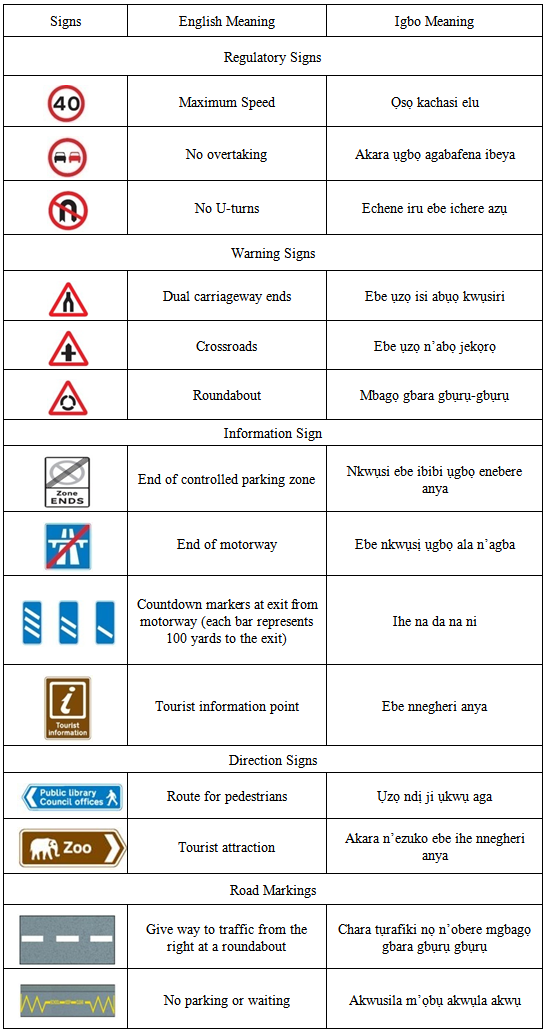 |
| |
|
A Petri net is a 5-tuple; | (1) |
where:P = {P1, P2, …, Pm} is a finite set of place;T = {T1, T2, …, Tn} is a finite set of transitions;F ⊆ (P×T) ∪ (T × P) is the set of arcs (flow relation);W: F→{1,2,3,…} is a weight function;M 0: P→{0,1,2,3,…} is the initial marking;P∩T =∅ and T ∩P =∅.
2.1. System Modeling
The behaviour of many systems can be described in terms of system states and their changes. In order to simulate the dynamic behaviour of this system, a state or marking in a Petri nets is changed according to the following transition (firing) rule: A transition t is said to be enabled if each input place p of t is marked with at least w(p,t) tokens, where w(p,t) is the weight of the arc from p to t. An enabled transition may or may not fire, depending on whether or not the event actually takes place.From (1);PN = <P, T, F, W, M0>where:P = {WP, RP, ULP, DP, LP, EvP, P1, P2, P3, P4, P5, ReP}, a finite set of places;T = {T1 ,T2 ,T3 ,T4 , T5, T6 , T7 ,T8, T9, T10, T11, T12}, a finite set of transitions; is a set of arcs (flow relation);
is a set of arcs (flow relation); and
and  M0 = {1};W = w(p,t), tokens on the arc.The model is shown in Figure 1a, 1b, 2 and 3. Figure 1a represent the main page where the user can register (RP), select from the tutorial options (TP) and evaluate (EvP) him or herself as well as display result (ReP). Figure 1b specify the page where the user can login (ULP) and choose from the tutorial’s options. Figures 2 and 3 show the tutorial page and evaluation page, respectively. The model has 12 places and 12 transitions which functions are as described in Table 2. The places are Welcome Page (WP), Result Page (RP), User Login Page (ULP), List Page (LP), Evaluation Page (EvP), Database (DB), Result Page (ReP) as well as P1 to P5 and the transitions are T1 to T12.
M0 = {1};W = w(p,t), tokens on the arc.The model is shown in Figure 1a, 1b, 2 and 3. Figure 1a represent the main page where the user can register (RP), select from the tutorial options (TP) and evaluate (EvP) him or herself as well as display result (ReP). Figure 1b specify the page where the user can login (ULP) and choose from the tutorial’s options. Figures 2 and 3 show the tutorial page and evaluation page, respectively. The model has 12 places and 12 transitions which functions are as described in Table 2. The places are Welcome Page (WP), Result Page (RP), User Login Page (ULP), List Page (LP), Evaluation Page (EvP), Database (DB), Result Page (ReP) as well as P1 to P5 and the transitions are T1 to T12.| Table 2. Places and Transition Description |
| | Places | Functions | Transitions | Functions | | WP | Displays welcome page | T1 | Fires from WP to RP | | RP | Display Registration Page | T2 | Fires from RP to ULP | | DB | Display Database | T3 | select the tutorial actions | | ULP | Displays user login page | T4 | Fires the EvP | | LP | Displays the list of tutorials | T5 | Fires the user's login action | | EvP | Displays result page Displays evaluation Page | T6 | Fires when option the option selected by the user is to logout | | P1 | Displays if user wishes to begin evaluation | T7 | Fires the display of different questions | | P2 | Displays “Yes” to continue with evaluation and “No” to end process | T8 | Fires to request if users wish to begin evaluation or not | | P3 | Displays different questions and options | T9 | Fires user's selection of Yes to begin | | P4 | Displays request to confirm user’s readiness for final submission and interaction with the database | T10 | Fires user's selection of No to opt out of evaluation | | P5 | Displays user’s termination of process if not submitting | T11 | Fires user's submission | | ReP | Display Result Page | T12 | Fires user's display of result. |
|
|
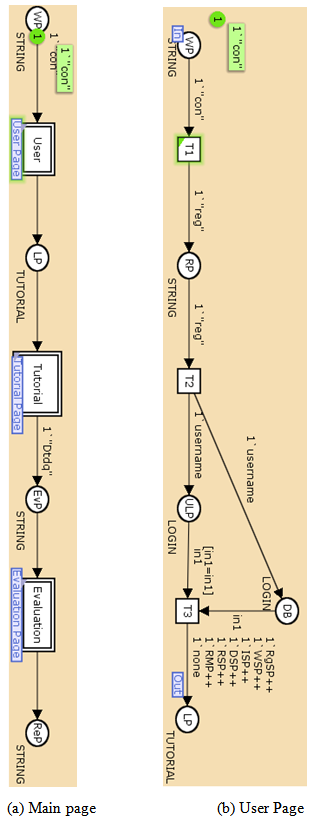 | Figure 1. CPN model of main page and user pag |
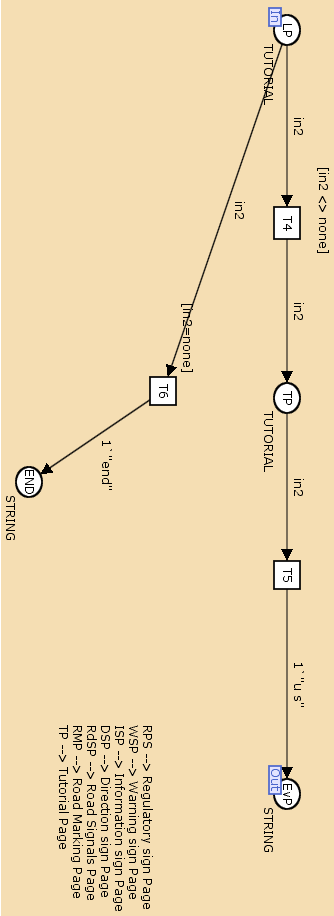 | Figure 2. CPN model of tutorial page |
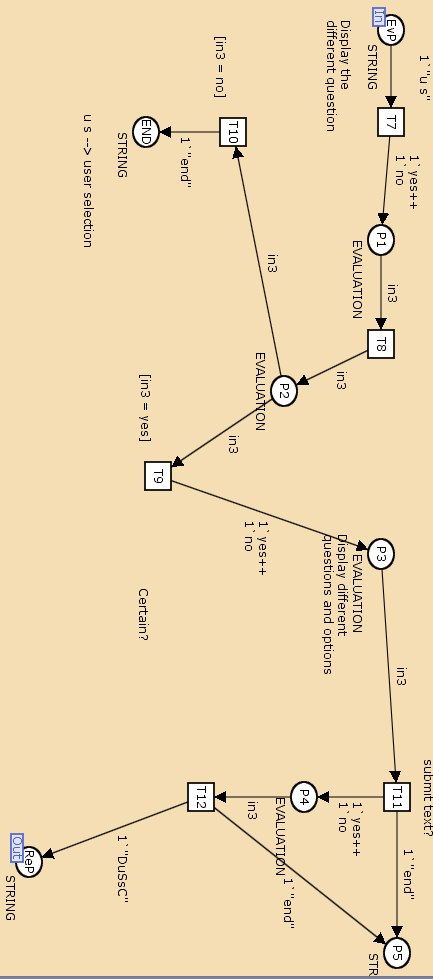 | Figure 3. CPN model of evaluation page |
2.2. Model Simulation
The behavior of this system is described in terms of system states and their changes. In order to simulate the behavior of this system, the state or the marking in the petri net is changed according to the firing rules. The presence of a token in a place is interpreted as holding the truth of the condition associated with the place. In other to confirm the effectiveness of the method presented in this study, the model was simulated using CPN 3.4.0 tool. Table 3 shows the typical interpretations of transition as well as their input and output places used.| Table 3. Interpretation of Places and Transition |
| | Input Places | Transition | Output Places | | WP | T1 | RP | | RP | T2 | ULP/ DB | | DB | T3 | LP | | ULP | T3 | LP | | LP | T4 | TP | | TP | T5 | EvP | | LP | T6 | END | | EvP | T7 | P1 | | P1 | T8 | P2 | | P2 | T9 | P3 | | P2 | T10 | END | | P3 | T11 | P4/P5 | | P4 | T12 | P5/ReP |
|
|
Note: If the token (i.e. the weight function) on a transition Tn equal the input to the transition Tn, then Tn fires.At WP, the system goes to RP, then to DB (if new user) else, ULP (if registered user). If the token on T3 = in1, then T3 fires and the system goes to LP. If in2 = none, T6 fires and the system goes to END, else T4 fires and the system goes to TP.If the tokens on T5=in2, T5 fires and the system goes EvP. If the token on T7=us, T7 fires and the system goes to P1. If the tokens on T8=in3, then T8 and the system goes to P2. If the token on T10=in3=no, T10 fires and the system goes to END, else if the token on T9=in3=yes, T9 fires and the system goes to P3. If the tokens on T11 = in3, T11 fires and the system goes to P5 (to terminate) else, P4. If the token on T12 = in3=no, T12 fires and the system goes toP5, but if the token on T12 = in3 = yes, T12 fires and the system goes to ReP. Figure 4 shows the CPN model for the evaluation page after the first simulation.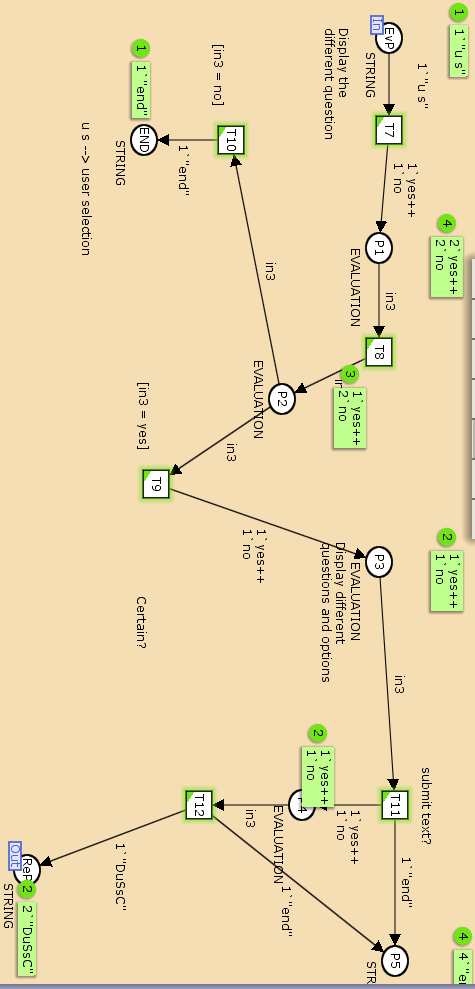 | Figure 4. CPN simulated model of evaluation page |
3. Implementation
The tutor has two components: a web browser and a web server ([7]; [16]). The web browser makes a request from the server while the server sends back a response. The web database transactions of user’s web browser issues a Hyper Text Transfer Protocol (HTTP) request for the user’s page for example; the web server receives the request, retrieves the file and passes it to the PHP engine for processing which begins parsing the script.Inside the script is a command to connect to the database and execute a query. PHP opens a connection to the MySQL appropriate query; the MySQL server receives the database query, processes it and sends the results back to the PHP engine; the PHP engine finishes running the script which will usually involve formatting the server and sends on the query results in HTML. It then returns the resulting HTML to the web server; the web server passes the HTML back to the browser, where the user can see the page requested for.
3.1. System Operation
The application is made up of user interfaces that enhance the smooth communication between the user and the system.The important operation of the system comprises of an introductory page, the user data and authentication page, the tutoring page and an assessment page. The introductory page provides a brief introduction on the purpose of the system and shows the link to the operations that can be performed on the system. The user data page shown in Figure 5 facilitates the collection of the necessary bio data of the user. This includes the first name, surname, age, and country of residence, the town and driving experience of users. This information is used to track the user’s progress and performance over time.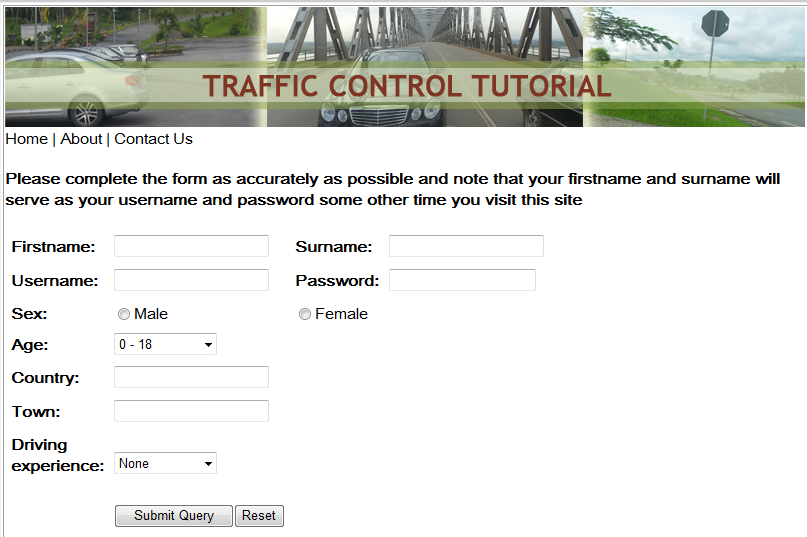 | Figure 5. Users bio data collection page |
A username and password (for users’ authentication) is created for the user at this stage for subsequent entry. The user authentication page shown in Figure 6 provides users’ identification and security to the designed system and it allows new and old users to enter a correct username and password before using the system.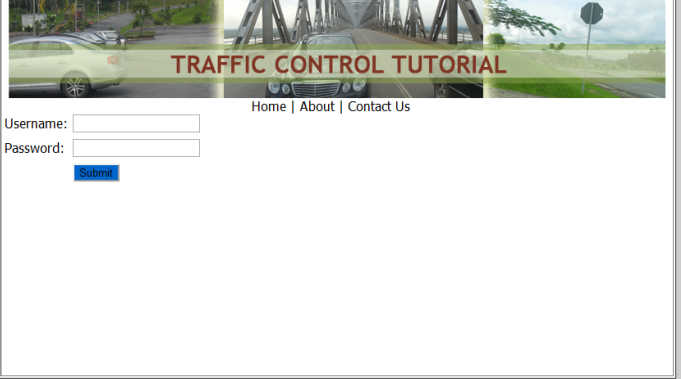 | Figure 6. Users authentication page |
The tutoring sub module presents the different categories of traffic signs, road markings and signals that the user may want to learn. These are the warning, regulatory, information and direction signs as well as the road markings and road signals. The description of each sign with the Igbo and English interpretation is shown in each category. This regulatory road signs tutor includes a description of each of the signs and their meaning in English and the Igbo language as shown in Figure 7.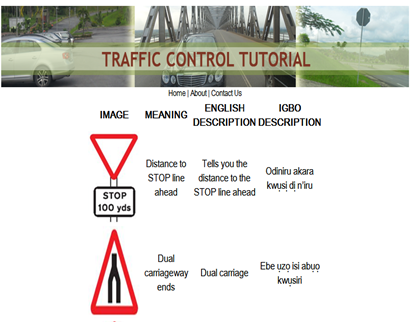 | Figure 7. The page for road sign tuition |
Similarly, the road warning and road signal pages provide tutorial on information, direction, warning signs and road signal. A description of each sign and signals as well as their meaning in English and the Igbo language are provided.The tutor is designed to present web pages of these signs and signals for the user to learn what each sign means and explore their relevance and function during driving, in English and Igbo languages. The evaluation sub module presents a set of questions to the user to determine their level of understanding of the subject as shown in Figure 8. It does this by randomly selecting twenty questions from a database of 146 multiple choice questions. The questions in the database are distributed as shown in Table 4. The aim of the questions is to test the driver on the meaning of the different traffic signs, road signals and road markings with options. Questions on RS, WS, IS, DS, RS and RM contributes approximately 21.23%, 36.30%, 16.44%, 3.43%, 15.75% and 6.85% of the total questions, respectively. This component of the system provides the user assessment function. The user taken the test is graded by the system and the system provides solution to the missing questions. Based on the result given by the system, the FRSC will recommend to the user and fix another time for him/her to come and retake the test expecting the user to have gone through the tutorial again. If the user passed a test, he/she is allowed to take other tests until the FRSC is satisfied with the evaluation.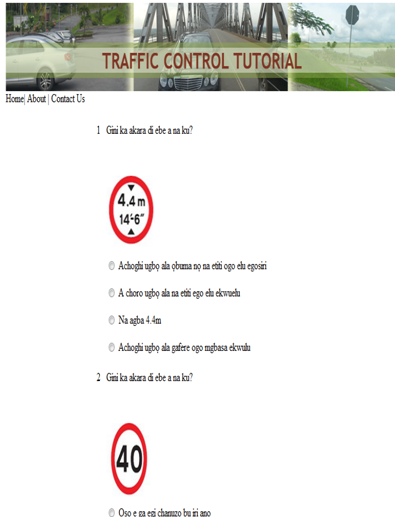 | Figure 8. User assessment interface |
Table 4. Question Analysis
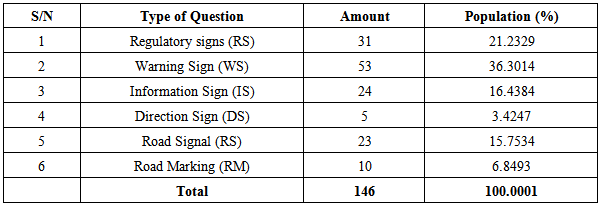 |
| |
|
4. Evaluation
The developed system was evaluated to determine its adequacy based on users’ assessment in terms of the content, ease of usage, response time as well as whether the system can serve as a language learning tool. When responding to the questionnaire items, respondents specify their level of agreement to the statement. The scales used were Very High, High, Average, Low and Very Low. The results and statistical analysis of the evaluation are presented in the Table 5. 30%, 40% and 30% of the respondents rated the overall performance of the system has been very high, high and average, respectively while 80% and 20% of the respondents rated the system serving as a language learning tool has been very high and high, respectively.Table 5. Result Analysis
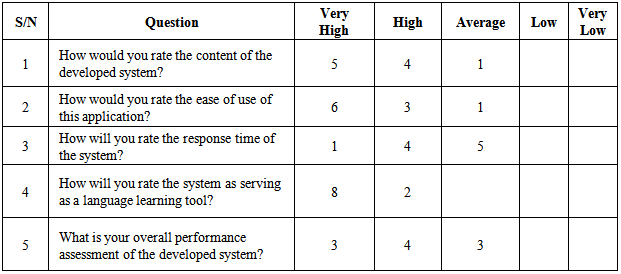 |
| |
|
5. Conclusions
In this paper we have reported our ongoing work into the development of a web based road traffic tutoring and assessment system for the Igbo speakers. The evaluation suggested that the users are more comfortable using the system as they are better able to appreciate the contents.The bilingual environment provided by the tutor can also serve as a language learning tool for the users. We are confident that the system will help in the effective and efficient teaching of the traffic signs and also provide self-evaluation for the users. Our future goal is to make the system multimedia by including audio and video component so as to further enrich the learners’ experience.
ACKNOWLEDGMENTS
This work is supported by Tertiary Education Trust Fund (TETFUND), TETF/DESS/NRF/OAU/STI/VOL.1/B1. 13.9. The authors would like to acknowledge Computing and Intelligent System Research Group (CISRG), Obafemi Awolowo University, Ile-Ife, Nigeria.
References
| [1] | American Safety Council (2006). Online Training for all Your Driving Needs. <http://www.safemotorist.com/articles/ traffic_signals.aspx>. Date assessed: December, 2013. |
| [2] | Barker, P. (2002). On Being an Online Tutor. Innovations in Education and Teaching International. Volume 39, Issue 1, pages 3-13. http://www.tandf.co.uk/journals. |
| [3] | Chukwu, G. (2005). ‘Igbo Women and Economic Transformation in South-Eastern Nigeria 1900-1960’ in Molefi Asante (ed.), African Studies History, Politics, Economy and Culture, London: Routledge: 237-246. |
| [4] | CIA (2014). Cia world factbook 2014. Available online at http://www.cia.gov/cia/publications/factbook. Visited April, 2014. |
| [5] | Crearie, L. (2013). Human Computer Interaction (HCI) Factors in Technology Enhanced Learning. ICICTE Proceedings. 99-108 |
| [6] | David's Driving School New market (2010). <http://www.dmdriving.co.uk/store/index.php/theory-test-software/theory-test-complete.htm>. Date assessed: June, 2011. |
| [7] | Deitel, P. and Deitel, H. (2007). Java: How To Program, 7th edition. Prentice Hall, Upper Saddle River New Jersey. |
| [8] | Federal Road Safety Commission (FRSC) (2005). http://www.frsc.gov.ng/2005annualreport.pdf. Date assessed: June 2011. |
| [9] | Gawande, V. (2009). Effective Use of HCI in E-Learning. The Sixth International Conference on eLearning for Knowledge-Based Society, 17-18 December 2009, Thailand. Pages 14.1-14.6 |
| [10] | Hashim A. and Abdul R. A. (2002). Accident Analysis & Prevention, Volume 34, Issue 2, Pages 185-196. |
| [11] | Murata, T. (1989). Petri Nets: Properties, Analysis and Applications. Proceedings of the IEEE. Vol 77 (4). Pp. 541-580 |
| [12] | Mwakalonge1, J. L., White, J. and Siuhi, S. (2014). Distracted Biking: A Review of the Current State-of-Knowledge. International Journal of Traffic and Transportation Engineering 3(2): 42-51. |
| [13] | Nyantakyi1, E. K., Owusu, P. A. and Borkloe, J. K. (2014). Methods for the Assessment of Performance Indication Measures at Amakom Intersection and their Application in Micro Simulation Modeling. International Journal for Traffic and Transport Engineering, 4(1): 35– 51 |
| [14] | Rozenbaum, A. N. (2014). Parameters of Condition and Dependability of Human-Machine System in Operation. Journal of Safety Engineering, 3(1): 13-17 |
| [15] | Ume, C.N. (2012). Development of a Web Based Educational System for Road Traffic Signs in English and Igbo Language. BSc. Thesis, Obafemi Awolowo University, Ile-Ife, Nigeria. |
| [16] | Weiling, L. and Thomson, L. (2001), ‘PHP and MySQL Web Development’. Sam Publishing, Indiana, pp 180-181. |


 is a set of arcs (flow relation);
is a set of arcs (flow relation); and
and  M0 = {1};W = w(p,t), tokens on the arc.The model is shown in Figure 1a, 1b, 2 and 3. Figure 1a represent the main page where the user can register (RP), select from the tutorial options (TP) and evaluate (EvP) him or herself as well as display result (ReP). Figure 1b specify the page where the user can login (ULP) and choose from the tutorial’s options. Figures 2 and 3 show the tutorial page and evaluation page, respectively. The model has 12 places and 12 transitions which functions are as described in Table 2. The places are Welcome Page (WP), Result Page (RP), User Login Page (ULP), List Page (LP), Evaluation Page (EvP), Database (DB), Result Page (ReP) as well as P1 to P5 and the transitions are T1 to T12.
M0 = {1};W = w(p,t), tokens on the arc.The model is shown in Figure 1a, 1b, 2 and 3. Figure 1a represent the main page where the user can register (RP), select from the tutorial options (TP) and evaluate (EvP) him or herself as well as display result (ReP). Figure 1b specify the page where the user can login (ULP) and choose from the tutorial’s options. Figures 2 and 3 show the tutorial page and evaluation page, respectively. The model has 12 places and 12 transitions which functions are as described in Table 2. The places are Welcome Page (WP), Result Page (RP), User Login Page (ULP), List Page (LP), Evaluation Page (EvP), Database (DB), Result Page (ReP) as well as P1 to P5 and the transitions are T1 to T12.







 Abstract
Abstract Reference
Reference Full-Text PDF
Full-Text PDF Full-text HTML
Full-text HTML

